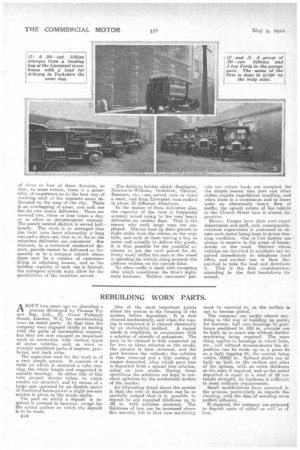REBUILDING WORN PARTS.
Page 16

If you've noticed an error in this article please click here to report it so we can fix it.
ABOUT two years ago we described a process developed by Thomas Try and Son, Ltd., 37, Great Pulteney Street, London, W.1, for counteracting wear on metal parts. At that time the company were engaged chiefly in dealing with the parts of aeronautical engines, but they are now engaged on important work in connection with various types of motor vehicles, such as worn or wrongly machined parts of engines, gearboxes, and back axles.
The apparatus used for the work is of a very simple nature. It consists of a table on which is mounted a tube running the whole length and supported in suitable bearings. At either side of this tube project shorter tubes, to which anodes are attached, and bymeans of a large cam operated by an electric motor of fractional horse-power a slight see-saw motion is given to the anode shafts.
'The part on which a deposit is required is covered in beeswax' except for the actual surface on which the deposit is to he made.
B14 One of the most important points about the system is the cleaning of the surface before deposition. It is first cleaned mechanically, and when the waxing is completed it is cleaned chemically by an electrolytic method. A copper anode is employed, in conjunction with a solution of cyanide of potassium. The part to be cleaned is first connected up for two or three minutes as the anode, the current is then reversed, and the part becomes the cathode; the solution is then removed and a thin coating (-If copper deposited, after which pure iron is deposited from a special iron solution, using an iron anode. During these operations the solutions are kept in constant agitation by the mechanical motion of the anodes.
An interesting detail about the system is that the rate of deposition can be so carefully judged that it is possible to deposit to any required thickness up to .02 in. with extreme accuracy. The thickness of iron can be increased above this amount, but in that case machining must be resorted to, as the surface is apt to become pitted. The company can tackle almost anything in the way of building up parts; for instance, ball rack i
housings n gearboxes machined to .010 in. oversize can be built up to exact size without further machining being required. The same thing applies to housings in wheel hubs, etc., and without measurements the deposition can be made up to a press lit or a light tapping fit, the control being within, .00025 in. Splined shafts can be built up both on the surface and sides of the splines, with an extra thickness at the sides if required, and as the metal deposited is equal to a steel of 60 ton tensile strength, its hardness is sufficient to meet ordinary requirements.
Small modifications have occurred in the process, particularly as regards the cleaning, with the idea of ensuring more perfect adhesion.
If required, the company are prepared to deposit coats of nickel as well as of iron.




































